
During the Second World War, the Roman Catholic Church protested against Aktion T4, the Nazi involuntary euthanasia programme under which 300,000 disabled people were murdered. The protests formed one of the most significant public acts of Catholic resistance to Nazism undertaken within Germany. The "euthanasia" programme began in 1939, and ultimately resulted in the murder of more than 70,000 people who were deemed senile, mentally handicapped, mentally ill, epileptics, cripples, children with Down's Syndrome, or people with similar afflictions. The murders involved interference in Church welfare institutions, and awareness of the murderous programme became widespread. Church leaders who opposed it – chiefly the Catholic Bishop Clemens August von Galen of Münster and Protestant Bishop Theophil Wurm – were therefore able to rouse widespread public opposition.
Catholic protests began in the summer of 1940. The Holy See declared on 2 December 1940 that the policy was contrary to natural and positive Divine law, and that: "The direct killing of an innocent person because of mental or physical defects is not allowed." In the summer of 1941, protests were led in Germany by Bishop von Galen, whose intervention, according to Richard J. Evans, led to "the strongest, most explicit and most widespread protest movement against any policy since the beginning of the Third Reich."[2] In 1943, Pope Pius XII issued the Mystici corporis Christi encyclical, in which he condemned the practice of killing the disabled. The Encyclical was followed, on 26 September 1943, by an open condemnation from the German Bishops which denounced the killing of innocent and defenceless people, whether mentally or physically handicapped, incurably infirm, fatally wounded, innocent hostages, disarmed prisoners of war, criminal offenders, or belonging to a different race.
- ^ Gill, Anton (1994). An Honourable Defeat; A History of the German Resistance to Hitler. London: Heinemann. p. 265.
- ^ Evans, Richard J. (2009). The Third Reich at War. New York City: Penguin Press. p. 98.
